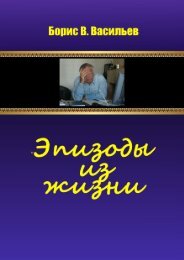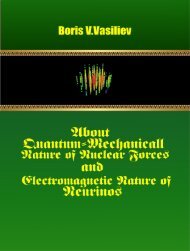978-1-940366-36-4_WholeBook
Boris V. Vasiliev Supercondustivity Superfluidity
Boris V. Vasiliev
Supercondustivity Superfluidity
You also want an ePaper? Increase the reach of your titles
YUMPU automatically turns print PDFs into web optimized ePapers that Google loves.
Chapter 1 Is It Possible for a Physical Theory to be Harmful?<br />
Simplistically the chain of reasoning, which can be formed, for example, by a student<br />
at his acquaintance with these theory may be as the next sequence:<br />
• theory created by the author is very complex;<br />
• this means that the author is very smart and knows a lot;<br />
• so smart and well-trained theorist should not be mistaken;<br />
• it means his theory is correct.<br />
All links in this chain of reasoning may be correct. Except the last. Theory is valid<br />
only if it is confirmed by experiments.<br />
It is essential that pseudo-theories can not be simplified for obtaining of an<br />
approximate, but correct and simple physical constructions.<br />
The correct approach to the explanation of the object can be mathematically difficult, if<br />
it aimed on an accurate description of the properties of the object. This approach should<br />
allow to get a simple estimation on the order of value.<br />
Another feature of pseudo-theories consists in substitution of experimental proofs. All<br />
objects under consideration of physical theories have main individual properties that can<br />
be called paramount. For stellar physics they are individual for each star radii,<br />
temperatures, masses. For superconductors - individual for each critical temperatures<br />
and magnetic fields, for superfluid helium - the transition temperature and the density of<br />
atoms near it, and so on.<br />
Quasi-theories are not able to predict the individual paramount properties of<br />
considered objects. They replace the study of the physical mechanisms of the formation<br />
of these primary parameters on a describing of general characteristics of the physics of<br />
the phenomenon and some of its common properties. For example, the theory of XX-th<br />
century substituted the explanation of the properties of specific superconductors by the<br />
prediction of the observed temperature dependence of the critical field or the energy gap<br />
which are characteristic for this phenomenon. As a result, it appears that there is an<br />
agreement between theory and experiment, although the general characteristics of the<br />
phenomenon can usually be called thermodynamic.<br />
Science Publishing Group 9













